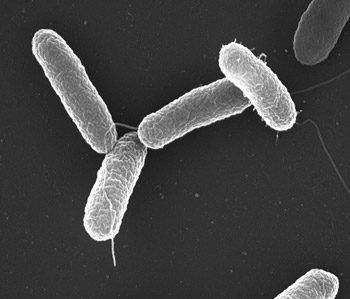Salmonella

Salmonella typhimurium. Image credit: Volker Brinkmann, Max Planck Institute for Infection Biology, Berlin.
Salmonella is a genus of motile, rodlike, Gram-negative (see Gram's stain) bacteria that inhabit the intestines of animals and humans and cause disease. They ferment glucose, usually with the formation of gas. Various species of salmonella cause food poisoning, enteritis, and septicemia. S. typhi and S. paratyphi cause typhoid fever and paratyphoid fever, respectively.
In many cases, the source of salmonella poisoning has been traced to poultry products, and particularly to hens' eggs and chicken meat. The infection of eggs can originate in the hen's ovaries or it may occur as a result of fecal contamination via the egg shell.
Symptoms of salmonella poisoning
Symptoms of salmonella food poisoning usually appear suddenly 12–24 hr after infection and include headache, nausea, abdominal pain, diarrhea, and sometimes fever. They usually last for only two or three days, but in severe cases dehydration or septicemia (blood poisoning) may develop, especially in the very young and old.
Treatment and prevention
Treatment is by rehydration therapy to replace lost fluids. In severe cases, fluid may need to be replaced by means of intravenous infusion.
In general, it is advisable to avoid foods that contain raw egg (such as homemade mayonnaise, mousses, and ice cream). The risk of infection is reduced in very fresh eggs. Salmonella organisms are not killed by light cooking, and eggs given to children or the frail or elderly should be well cooked.


